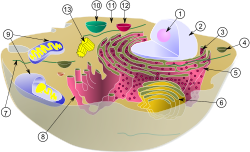
Back عضية خلوية Arabic Orqanellər Azerbaijani Арганоіды Byelorussian Клетъчни органели Bulgarian অঙ্গাণু Bengali/Bangla Organit Breton Organela BS Orgànul Catalan Органелла CE ئەندامۆچکە CKB

In cell biology, an organelle is a part of a cell that does a specific job.
Organelles usually have a plasma membrane around them.[1] Most of the cell's organelles are in the cytoplasm.[2][3]
The name organelle comes from the idea that these Structures are to cells what an organ is to the body.
There are many types of organelles in eukaryotic cells. Prokaryotes were once thought not to have organelles, but some examples have now been found.[4] They are not organized like eukaryote organelles, and are not bounded by plasma membranes. They are called bacterial microcompartments.[5]
- ↑ See 'Scope of the term' below.
- ↑ Alberts, Bruce et al. 2003. Essential cell biology, 2nd ed. Garland Science.
- ↑ National Research Council (U.S.). Committee on Research Opportunities in Biology (1989). Opportunities in biology. National Academies. p. 104. ISBN 978-0-309-03927-7. Retrieved 23 December 2010.
- ↑ Kerfeld C.; et al. (2005). "Protein structures forming the shell of primitive bacterial organelles". Science. 309 (5736): 936–8. Bibcode:2005Sci...309..936K. doi:10.1126/science.1113397. PMID 16081736. S2CID 24561197.
- ↑ Bobik T.A. (2007). "Bacterial microcompartments" (PDF). Microbe. 2. Am Soc Microbiol: 25–31. Archived from the original (PDF) on 2008-08-02. Retrieved 2011-01-06.